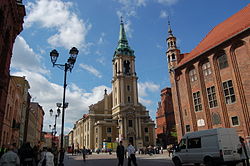Torun, Poland
| Toruń | |||
|---|---|---|---|

Top: Town hall on Stary Rynek
Middle: Dąmbski family Palace, Bridge Gate, Nicolaus Copernicus Monument Bottom: Toruń's medieval Old Town panorama |
|||
|
|||
| Nickname(s): , Gingerbread city, Copernicus Town | |||
| Motto: "Durabo" (Latin: "I will endure") | |||
| Coordinates: 53°2′N 18°37′E / 53.033°N 18.617°E | |||
| Country | Poland | ||
| Voivodeship | Kuyavian-Pomeranian | ||
| County | city county | ||
| Established | 13th century | ||
| City rights | 1233 | ||
| Government | |||
| • Mayor | Michał Zaleski | ||
| Area | |||
| • City | 115.75 km2 (44.69 sq mi) | ||
| Elevation | 65 m (213 ft) | ||
| Population (2014) | |||
| • City | 203,148 | ||
| • Density | 1,800/km2 (4,500/sq mi) | ||
| • Metro | 297,646 | ||
| Time zone | CET (UTC+1) | ||
| • Summer (DST) | CEST (UTC+2) | ||
| Postal code | 87-100 to 87-120 | ||
| Area code(s) | +48 56 | ||
| Car plates | CT | ||
| Website | http://www.torun.pl/ | ||
| Official name | Medieval Town of Toruń | ||
| Type | Cultural | ||
| Criteria | ii, iv | ||
| Designated | 1997 (21st session) | ||
| Reference no. | [1] | ||
| UNESCO region | Europe | ||
| Medieval Town of Toruń | |
|---|---|
| Name as inscribed on the World Heritage List | |
 |
|
| Location | Poland |
| Type | Cultural |
| Criteria | ii, iv |
| Reference | 835 |
| UNESCO region | Europe and North America |
| Inscription history | |
| Inscription | 1997 (21st Session) |
Toruń [ˈtɔruɲ] (German: Thorn) is a city in northern Poland, on the Vistula River. Its population was 202,591 as of June 2016. Previously it was the capital of the Toruń Voivodeship (1975–98) and the Pomeranian Voivodeship (1921–45). Since 1999, Toruń has been a seat of the self-government of the Kuyavian-Pomeranian Voivodeship and, as such, is one of its two capitals (together with Bydgoszcz). The cities and neighboring counties form the Bydgoszcz-Toruń twin city metropolitan area.
Toruń is one of the oldest cities in Poland, having been established in 1233 by the Teutonic Knights. Over centuries, it was the home for people of diverse backgrounds and religions. At one point, the city was considered the most modern cultural and technological centre in Medieval Europe. From 1264 until 1411 Toruń was part of the Hanseatic League and by the 17th century it was one of the elite trading points, which greatly affected the city's architecture ranging from Brick Gothic to Mannerism and Baroque. Throughout different periods of time, the city was part of Poland, Prussia and Germany; prior to World War I, the city was located within the Prussian region of the German Empire. After Poland declared independence in 1918, Toruń was incorporated into Polish territory, and, during World War II, as one of few cities in the country, it sustained no damage. This allowed the Old Town to be fully preserved with its iconic central marketplace.
...
Wikipedia



